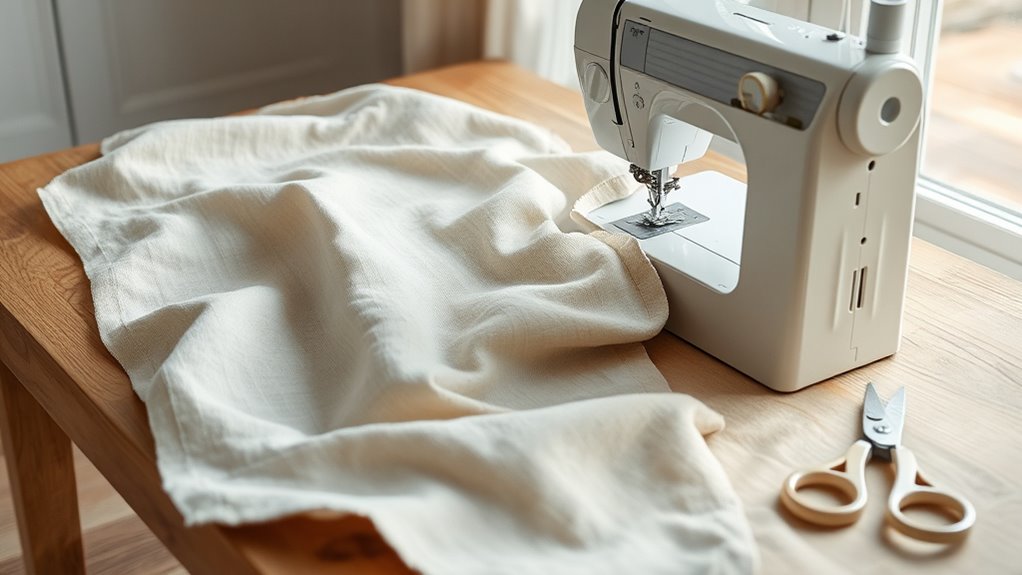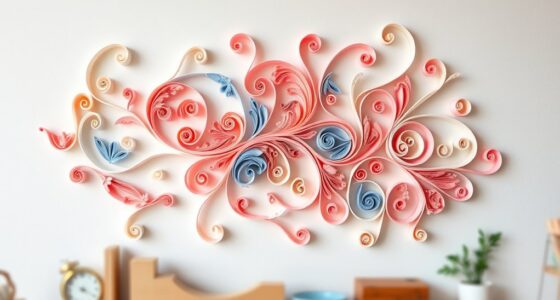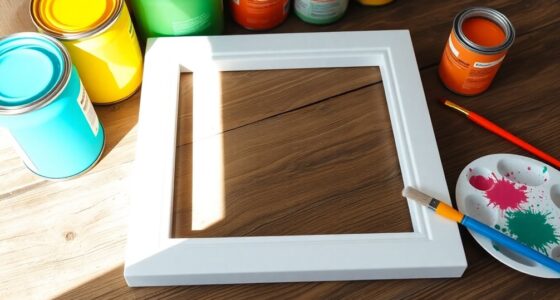To sew a simple curtain panel, start by choosing your fabric based on your style and room needs. Measure your window, add extra inches for hems and fullness, then cut your fabric accordingly. Fold and sew the edges for clean hems, and create a rod pocket at the top by folding down and sewing across. Attach your curtain to the rod using clips or sewn loops. Keep going to discover how all these steps come together for a perfect finished look.
Key Takeaways
- Measure your window and add extra inches for hems and fullness before cutting fabric.
- Choose a fabric suitable for your room’s style and light control needs, and cut it to the desired size.
- Fold and sew hems along raw edges for a clean finish, and create a rod pocket at the top for hanging.
- Select a curtain rod that complements your decor, ensuring it is sturdy and extends beyond the window frame.
- Attach the fabric to the rod using clips or sewn loops, then install for a personalized, polished look.

Sewing a simple curtain panel is a quick and rewarding project that can instantly update your space. The first step is choosing the right fabric selection, which sets the tone for your entire window treatment. Think about the mood you want to create—light and airy fabrics like linen or cotton work well for a breezy, casual look, while heavier materials such as velvet or thick canvas add a touch of sophistication and help with light control. Consider the room’s purpose and existing decor; if you’re aiming for a minimalist vibe, opt for solid, neutral tones. For a more vibrant or patterned look, choose fabrics with subtle designs that complement your color scheme. Pay attention to fabric durability, especially if the curtains will be near windows that see a lot of sunlight, as some fabrics may fade or weaken over time. Once you’ve selected your fabric, determine the size of your curtain panel by measuring the window width and height, adding extra inches for hems and fullness. It’s also helpful to consider the fabric’s light filtration qualities to ensure it meets your privacy and brightness preferences.
Next, you’ll want to explore your curtain rod options. Your choice of curtain rod influences both the style and functionality of your finished project. For a sleek, modern look, consider slim metal rods or tension rods that require minimal installation. If you’re after a more traditional or decorative aesthetic, opt for wooden rods with ornate finials or painted finishes. Make sure the curtain rod you select can support the weight of your fabric; heavier fabrics need sturdier rods with appropriate brackets. The length of the rod should extend beyond the window frame on each side to allow the curtains to open fully and maximize natural light. Installing the rod at an appropriate height—usually a few inches above the window frame—can make your windows appear larger and your ceilings taller.
Once your fabric is chosen and your curtain rod is ready, cut your fabric to size, leaving extra for hems. Fold the edges over twice to create clean, finished hems and sew along the edges for a polished look. If you want to add a rod pocket, fold the top edge to the desired pocket width, sew across, and slide the rod through later. Attach the fabric to your curtain rod using clips or by sewing loops or tabs, depending on your design preference. With a little patience and attention to detail, you’ll have a custom-made curtain panel that enhances your space and showcases your sewing skills. The process is straightforward, and the results are worth the effort, transforming your room with a personalized touch.
Frequently Asked Questions
What Fabric Is Best for Thermal Insulation?
For thermal insulation, you should choose a fabric made from thermal fabric or insulating materials like wool, fleece, or heavy cotton. These materials trap air and reduce heat transfer, keeping your space warmer. Look for fabrics with a dense weave or added lining, as they enhance insulation. When sewing your curtain panel, selecting the right thermal fabric helps you maintain a cozy indoor environment and saves energy.
How Do I Measure for Custom Curtain Length?
You should measure for custom curtain length using a measuring tape, starting from the curtain rod down to your desired length, whether that’s just below the window or to the floor. Add extra fabric for hems, usually about 1-2 inches. Keep fabric thickness in mind, especially if you’re using heavy materials. Use your sewing machine to stitch hems securely, ensuring your curtain hangs perfectly.
Can I Sew Curtains Without a Sewing Machine?
Yes, you can sew curtains without a sewing machine by using fabric glue, fusible webbing, or hand sewing techniques. These DIY window treatments require patience and some sewing tips, like carefully measuring and pinning fabric before sewing by hand. This approach is perfect if you want a quick, no-machine solution or enjoy crafting manually. Just make certain you choose suitable fabrics and tools to achieve a polished, professional look.
How Do I Prevent Curtain Wrinkles During Washing?
To prevent curtain wrinkles during washing, you should use gentle washing tips. Wash your curtains in cold water on a delicate cycle, avoiding overloading the machine. Remove them promptly and hang them to dry while still damp to minimize wrinkles. If needed, use a low heat iron or steamer to smooth out any creases. These wrinkle prevention strategies keep your curtains looking fresh and neat after washing.
What Are Eco-Friendly Fabric Options for Curtains?
You’ll love eco-friendly fabric options for curtains—really, they’re just as stylish! Opt for natural fibers like organic cotton, linen, or hemp for a sustainable touch. Recycled fabrics, such as repurposed polyester or reclaimed textiles, add charm and reduce waste. These choices not only cut your environmental impact but also prove that eco-conscious can be chic. So go ahead, make a statement with curtains that are kind to the planet!
Conclusion
Once you’ve sewn your curtain panel, you’ll notice how perfectly it fits your space—almost as if it was meant to be there all along. Sometimes, the simplest projects turn out to be the most satisfying, making you wonder if fate played a hand. With just a bit of fabric and effort, you’ve created something that transforms your room. Plus, who knew that a quick sew could lead to such a beautiful surprise? Enjoy your new, custom-made curtain!








